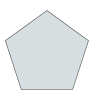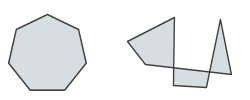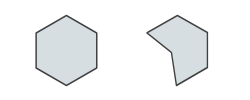Polygon Classification
Reference > Mathematics > Geometry > PolygonsIn a previous unit, we explored the world of Quadrilaterals. The definition given of a quadrilateral was: "A quadrilateral is a closed figure which is bounded by four straight line segments."
The definition of a Polygon is very similar: "A quadrilateral is a closed figure which is bounded by three or more straight line segments."

The image above is of a polygon with five sides, which is called a pentagon. In this reading we'll look at different ways of classifying polygons into categories.
Names of Polygons with n sides
Depending on the number of sides a polygon has, we assign it a different name. There are two basic ways to assign the name. The simplest way is to simply refer to a polygon with n sides as an n-gon. For example, a polygon with seven sides is a 7-gon.
However, there are "prettier" names that get used a lot in mathematics, and students should be familiar with the most common names, which are listed below:
3 sides: triangle
4 sides: quadrilateral
5 sides: pentagon
6 sides: hexagon
7 sides: heptagon (or septagon)
8 sides: octagon
9 sides: nonagon
10 sides: decagon
Those are just the most common ones, but it's amazing how many different kinds of polygons have names. For example, a 13-gon is also called a triskaidecagon and a 90-gon is also called an enneacontagon.
Don't worry--it's not likely that you'll have to know those two names!
Simple vs. Complex
A simple polygon is a polygon in which none of the bounding line segments cross each other. If any of the bounding segments intersect anywhere other than their endpoints, the polygon is considered to be complex.

Regular vs. Irregular
Simple polygons can be split into categories ofregular and irregular. A Regular polygon is a polygon in which all the bounding line segments and vertex angles are of equal measure. A regular polygon is a symmetric figure. If some angles or sides are not of equal measure, we call the polygon irregular.
Concave vs. Convex
If you have glasses, or have ever played with lenses, or have seen a distorting mirror, you've probably heard the terms convex and concave.
An example of a convex lens would be a magnifying glass, which bulges outward on both sides. Most glasses have lenses which are convex on one side (they bulge outward) and concave on the other side.
If you have a hard time remembering the difference between concave and convex, picture a cave as an indentation in the side of a hill. If something is concave, it has an indentation. Another way to remember it is to think of the noun form of "concave," which is "concavity". A cavity is a hole.
If an angle of a polygon is concave, it has a measure greater than 180 degrees.
When we're talking about polygons, however, we don't ever say "it's concave on one side and convex on the other." If a polygon has any concavities, we refer to it as a concave polygon. Thus, in the example below, the polygon on the left is convex, and the polygon on the right is concave.

Fully Describing Polygons
We can use the information given in this reading to fully describe any polygon. For example, the polygon in the first image of this reading is a simple, regular, convex pentagon. Note that if a polygon is complex, we don't need to specify whether it is regular, or whether it is convex.
Questions
 Unit Index
Unit Index Polygon Angles
Polygon Angles
